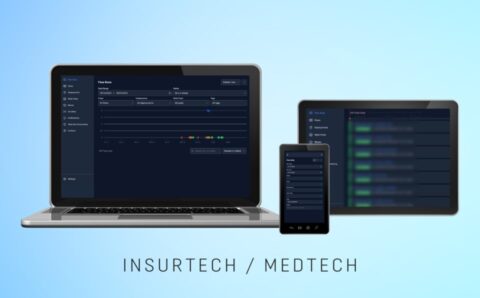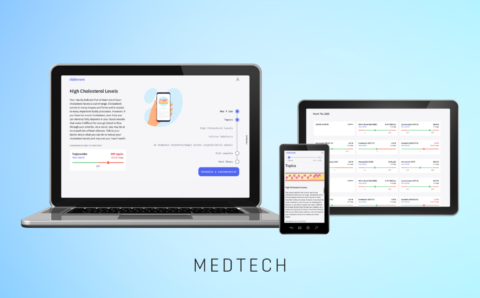
Medical software has become an indispensable element of the healthcare domain in the last couple of decades, delivering booming digital solutions to take patient care to the next stage. Now, healthcare specialists are able to streamline administrative procedures, patient registration, medical history tracking, diagnosis’ identification, therapy planning, medicine prescribing, follow-up care, billing, and even more. From health platforms, medical software has drastically changed the way healthcare vendors perform and deliver their services.
So, how much does it cost to create medical software? Let’s explore the determining factors that impact the expenses of creating medical solutions and provide tips on saving your expenses within this procedure. To get a clearer estimate tailored to your project needs, you can use a web development cost calculator, making budget planning more accurate and efficient.
Table of Contents:
Benefits of using custom medical software
Let’s define the key reasons why custom healthcare software development has become an indispensable part of medical business processes.
Capabilities
Healthcare software ensures a great diversity of opportunities that can assist medical workers in renovating patient care and optimizing their interactions. Telemedicine and patient monitoring, to illustrate, are aimed at remote customer serving and health conditions tracking. With electronic medical records (EMR), you are able to securely store digital versions of patients’ medical records that include medical history, test results, and medication prescription making it easier to make informed treatment decisions. With a medical billing system, you can automate the billing and coding process, making it easier to submit insurance claims and manage payments. Besides, you can benefit from medical software analytics capabilities, allowing healthcare to explore patient data to identify trends and patterns that can enhance the therapy process.
Security
With the custom approach, you can get tailored medical software that will be created particularly for your entity, guaranteeing the product is secure, reliable, and compliant with industry-specific guidelines and regulations. In addition, custom medical solutions give you the opportunity to manage electronic patient health information (ePHI) access. With the lack of dependency on third-party tech teams (in contrast to off-the-shelf solutions,) your organization’s healthcare solutions will be protected and regularly updated with the cutting-edge security practices and methods.
Flexibility
Bespoke solutions mean that you have no limit within your ideas and can implement required functionality. Based on the needs and workflows of a specific company, custom medical software provides much greater flexibility than readymade solutions. As a result, you don’t need to adapt your processes to fit the software. Conversely, the solution streamlines your processes and ensures better service for customers. This makes it beneficial for both patients and healthcare providers.
Features
Each healthcare software solution type has its own specific features. This means that each functionality element is inherent to the particular digital product. Let’s describe the core features to implement in every solution type. Please remember that functionality can always be adapted to your specific requirements with an opportunity to add more features to the product.
Medical insurance
Medical insurance software helps insurance and healthcare companies securely collect health data, manage billing processes, insurance claims, documents, and conduct encrypted end-to-end communication. Organizations opt for such a product to reduce errors and costs and improve the quality of service. It can be tailored to meet the requirements of different entities and integrated with other existing medical systems to create a seamless ecosystem for a certain company.
Plan aggregator
A plan aggregator is a platform that allows users to compare and purchase health insurance policies from different insurance providers. The aggregator software pulls information from various medical insurance companies and presents it to the user in a single interface, allowing them to compare the existing offers and prices at one place. This helps users make informed decisions and choose the option that best meets their needs and budget.
Eligibility check
Eligibility check allows healthcare providers to quickly determine whether a patient is covered by their insurance plan. This verification cuts down on organizational errors and ensure that patients receive the appropriate level of services.
Claims processing
Another integral functionality element is claims processing which robotizes the procedure of submitting and processing insurance claims. Its vital purpose is to reduce the administrative burden on healthcare vendors and improve the speed and accuracy of claims processing.
Security
Any type of healthcare software must be designed with security in mind to Personally Identifiable Information (PII) and financial details. Security features can include user authentication, encryption of data in transit and at rest, as well as access controls to ensure that only authorized users can access sensitive information.
Reporting and analytics
Reporting and analytics allow insurance organizations and medical providers to track key metrics such as claims processing times, costs, as well as customer satisfaction. This information can help companies make reasonable and well-thought-out business decisions to boost the efficiency and speed of insurance operations.
Billing
A healthcare biling solution software targeted at delivering assistance to healthcare institutions and medical billing companies. Its main value is in optimized management of the billing and reimbursement processes in the healthcare industry. The development of medical billing software requires a deep understanding of the healthcare industry, as well as the regulatory and compliance requirements that govern billing and reimbursement. Developers of medical billing software must have expertise in software development, as well as knowledge of healthcare data standards, security and privacy regulations, and insurance industry requirements. Medical billing software development cost will be determined based on the features to include. It typically comprises:
Claim Management
A billing claim is a request for payment that is submitted by a healthcare provider or facility to an insurance company or government program to receive reimbursement for services rendered to a patient. The software can automatically generate claims based on the services provided to patients, verify insurance eligibility, and submit claims to insurance companies electronically.
Online Payments
This feature enables patients to pay their medical bills online through the billing software. Patients can securely enter their payment information, view their current balance, and make payments on their outstanding bills. This becomes possible with payment gateway integration based on specific application programming interfaces (APIs).
Payment History
Payment history provides a record of all payments made by patients, insurance companies, or other payers. It simplifies the process of tracking balances and identifying patterns in payment behavior. It also keeps full transparency to patients who want to check their payment history.
Billing Templates
It implies that patients are able to create pre-built templates for common billing scenarios. Billing templates can be set to match the particular requirements of a healthcare business, including diagnosis codes, procedure codes, and billing rates. Templates can streamline the billing process and ensure that all necessary information is included on the claim form.
Telemedicine
Telemedicine software is a fundamental healthcare technology that enables providers to deliver medical services remotely through digital communication channels, such as video conferencing, encrypted messaging, or in- app voice calls. Such a product typically includes a range of features that enable healthcare providers to interact with patients virtually and streamline distant therapy delivery.
Messaging and video chats
Virtual communication and appointment holding are impossible without messaging and video chat functionality. It enables physicians to interact with patients in real-time using secure messaging or video conferencing. With it, both parties always stay available for each other and are able to efficiently complete the therapy.
ePrescribing
ePrescribing functionality allows medical vendors to send electronic prescriptions directly to a patient’s preferred pharmacy. This feature enables physicians to quickly and easily prescribe medications to patients during telemedicine visits, improving patient convenience and satisfaction.
Scheduling
The scheduling feature enables patients to book appointments with healthcare providers online. This can help streamline the appointment booking process and improve patient access to care, conducting virtual doctor visits at the most convenient time possible from the comfort of their homes.
Patient Portal
Telemedicine software with an implemented patient portal provides patients with secure online access to their medical information, including test results, prescriptions, and medical history. Patients can also use the portal to schedule appointments, communicate with healthcare providers, and view their billing information.
Medical History
This function allows medical workers to access and track patients’ medical history, including diagnoses, medications, allergies, and other important information. Therefore, physicians are able to deliver more personalized and effective care to patients during telemedicine appointments based on the PII stored in their medical history.
Alerts & notifications
Alerts and notifications functionality is a must-have feature for telemedicine solutions, as it sends reminders to both parties (medical workers and patients) about upcoming appointments, medication refills, and other significant healthcare tasks. It also refines patient adherence to treatment plans as well as the outcomes.
Computerized Physician Order Entry (CPOE)
CPOE functionality provides healthcare vendors with an opportunity to enter medical orders electronically, comprising lab tests, imaging studies, and medications. By implementing this feature, you can reduce errors and bring more solid patient safety during online appointments.
EHR
Electronic Health Record or EHR is an electronic version of a patient’s medical record that contains a patient’s health information, such as medical history, diagnoses, medications, treatment plans, immunization dates, laboratory and test results, and other health-related information. This platform is designed to provide a comprehensive view of a patient’s health history and facilitate the sharing of information between healthcare providers.
Preventative Analytics
EHR software with preventative analytics functionality uses algorithms and PII to identify patients who may be at risk for certain health conditions or diseases. This useful function allows healthcare providers to proactively engage with patients and develop preventative care plans to improve patient outcomes.
Predictive Diagnoses
The predictive diagnoses feature has Machine Learning technology implemented. Having access to patient’s details, doctors can have a smart tool that predicts potential diagnoses or health outcomes. Besides, doctors can easier identify health-related problems early on and create individual and effective treatment plans.
Dashboards
Healthcare institutions implement dashboards to have a visual summary of key patient information, such as lab results, medications, and vital signs. Medical providers are able to quickly assess a patient’s health status and create informed clinical strategies.
Reports
Having a reports functionality allows clinicians to generate custom reports based on patient health data. This function can also play a key role in tracking patient progress, identifying trends, and measuring the impact of the treatment process.
Inventory Management
Tracking medical supplies and equipment, such as medications, medical devices, and laboratory supplies, becomes much easier with inventory management. Therefore, medical establishments are always sure they have the necessary resources to provide quality care to patients, and all of them are allocated wisely.
EMR
Electronic Medical Record (EMR) is a solution similar to EHR, as it also covers digital healthcare records of patients covering medical details, like treatment information and history, diagnoses, prescribed drugs, therapy strategies, immunization times, lab and test results, and other PII. However, in contrast to EHRs described above, EMRs are implemented to fit the needs of a single healthcare company or institution and are not created to be accessed across numerous clinics or organizations.
User access management
EMR systems allow administrators to control user access to patient-sensitive healthcare details. With user management access, you can be sure that only authorized parties have private patient information available. Such systems primarily incorporate specific user roles and permissions, password policies, and audit logs to track who accessed what information and when.
Compliance
Compliance with various regulations and standards, such as HIPAA (Health Insurance Portability and Accountability Act), is obligatory within healthcare solutions. Meeting required compliance allows you to protect the privacy, confidentiality, and security of patient health information. EMR systems include security features such as access control, data encryption, and secure messaging to ensure that businesses meet these regulations.
EMR templates
This function offers pre-designed templates for documenting patient information, such as clinical notes, assessments, and other documentation. Medical providers can edit templates to reflect their certain needs and can develop new templates with two clicks as required. Medical institutions get standardized documentation by applying templates, which can improve therapy coordination and service quality.
Lab data
An all-around medical hub stores laboratory test results and other diagnostic details, making it possible for clinicians to access and manage this information conveniently when required. Moreover, you can also generate alerts when abnormal results are detected, helping medical workers identify potential health issues early on. This functionality element of EMR supports clinical decision-making, treatment strategies’ creation, and follow-up care.
Unlock the Power of Custom Software
Learn how custom software can give your healthcare business a competitive edge, improve efficiency, and drive growth.
Healthcare development cost factors
Let’s consider some of the key factors that impact the cost of developing healthcare software.
Functionality
The type of software, the complexity of the features, and the functionality required in healthcare software will have a significant impact on the cost of development. More complex functionality and integration of technologies, such as Artificial Intelligence or Machine Learning algorithms, will require extended timelines and high expertise, which can substantially raise costs.
Design
A user-friendly, visually appealing interface entails raised design resources and takes longer to implement than a more simplistic design. Besides, in case a medical establishment has specific corporate colors and logos, they will also be considered during the design.
Performance
Healthcare software needs to perform quickly and reliably, especially for critical tasks like processing medical data and communicating with other systems. Developing bespoke software that meets these requirements can require additional time and resources, which can increase development costs. Yet, medical solutions performing smoothly, solidly, and quickly will recoup your costs due to the optimization opportunities they bring.
Technologies
The choice of technology stack can also impact development costs. Different programming languages, frameworks, and libraries can have different development times, which can impact the overall cost of the project. Additionally, newer technologies may be more expensive to implement due to a scarcity of skilled developers or specialized hardware requirements. The well-suited solution stack for healthcare web applications covers the Python programming language along with its frameworks like Django. These tech tools are appreciated by software developers for their security and comprehensibility.
Security
Healthcare digital products are designed following the best security practices due to the sensitive nature of PII as well as the obligatory requirement to meet healthcare guidelines and regulations. Implementing security features like data encryption, secure authentication, and access control will prolong the development flow and increase expenses at the same time.
Storage
The volume of data healthcare software needs to store, and process may also change the investments’ amount. Large amounts of data require more storage resources, respectively, so you may need to invest some extra costs.

AI Healthcare Platform
We delivered an AI-powered platform that enhances healthcare admin efficiency and service quality by automating patient interactions and tasks.

Elaborate
Elaborate’s software enhances patient understanding of lab results with clear summaries, notifications, and scheduling follow-up appointments.
Healthcare development cost calculator
A custom medical software development cost calculator is a tool that helps estimate the cost of implementing a medical software solution. It breaks down the development process into different stages and provides estimates for each stage based on various factors. Here’s a breakdown of some of the integral stages included in a healthcare development cost calculator:
Concept development
This stage involves creating a pipeline for the healthcare software application. It includes activities such as market research, requirements gathering, and creating a project implementation plan. The cost for this stage is typically estimated based on the complexity of the project and the time required to complete the mentioned procedures.
Design
Creating the user interface (UI) and user experience (UX) design is the next step for medical software implementation. The number of screens and the complexity of the UI/UX design are the cost-determining factors within this phase.
Development
It refers to actually building and implementing the healthcare software application. The number of features, the complexity of the functionality, and the technologies applied primarily define the price.
Testing
Testing enables Quality Assurance engineers to ensure that the healthcare digital product performs as required, meets quality standards, and lacks bugs or other technical issues. The complexity of the application and the time required for testing play a critical role when estimating the costs for this phase.
Support
Developers provide ongoing support and maintenance for the healthcare software application, renovating obsolete functionality elements, as well as updating the product with new features. The level of support required and the duration of the support contract will identify healthcare software development cost.
Marketing
What’s more, marketing can also have a significant impact on app development cost if you build a public product. If the marketing strategy is extensive and requires a lot of user research, advertising, and user engagement efforts, it can add to the expenses of healthcare app development. It’s important to mention that the initial stages of creating your medical app, the marketing-to-development cost ratio will be 20/80, but as the product develops, this ratio will shift to 80/20.
| Type of work | Cost |
| Concept development | $5,000 – $10,000 |
| Design | $10,000 – $20,000 |
| Development | $50,000 – $100,000 |
| Testing | $10,000 – $20,000 |
| Support | $5,000 – $10,000 monthly |
Need a Competitive Edge in Healthcare?
Partner with us to develop software that streamlines operations, increases revenue, and delivers a superior patient experience.
Cost-saving tips
Here are some tips for decreasing the cost to build healthcare software when developing healthcare software:
Predefine your budget
Predefining your expenses allows you to avoid unexpected costs and keep the project on track. Consider ordering a detailed budget breakdown from your tech partner that includes estimates for each stage of the software development lifecycle, comprising each step.
List your requirements
Clearly describing the requirements of your medical software can help you avoid unnecessary development work, which can save time and costs. Make sure you prioritize the features that are most important for your application and comprehensively deliver those priorities to your development team.
Approach experts for estimates
Before proceeding to the development process, it’s vital to get a realistic estimate of the final cost of the project. You are welcome to approach software development companies who specialize in healthcare software development to get more precise estimates, as making the calculations without a technical vendor will be obscure and insufficiently accurate. By comparing estimates from different sources, you can get a better idea of the overall cost and identify potential areas where you can save on your expenses and which software development company meets your budget opportunities.
Choose a development team with expertise
Hiring a team of software engineers in healthcare software development will eliminate costly mistakes and guarantee that your project is implemented by meeting the set deadlines and budget. Look for a team with experience in the medical industry and similar healthcare products, and check their references and portfolio to make sure they have the necessary skills and experience.
Use Agile development methodologies
Sticking to the Agile software-building approach can also help cut down expenses by enabling you to make changes to the software solution as needed throughout the entire development process. By breaking the project down into smaller, manageable sprints, you can adjust the project in dynamics as required, maximize its quality, and make it as relevant as possible.
Healthcare software development costs can vary greatly depending on a variety of factors we’ve mentioned in this article. While it can be tempting to cut corners or choose the cheapest option, it’s crucial to remember that investing in quality custom development can ultimately save you time and costs in the long run. By taking the time to thoroughly plan and budget for your software development project and choosing a credible software development team with proven domain expertise, you can ensure that your project is completed on time, within budget, and to your exact specifications.
Let’s transform the healthcare industry together with your innovative solutions. This sector is in dire need of advanced technologies that can help medical professionals provide quality care to patients, so you have the power to make a difference. Level up your medical company by developing cutting-edge software that enhances patient therapy, streamlines workflows, and renovates the overall business environment. PLANEKS qualified experts and resources are always at your disposal to boost your healthcare company. Contact us to discuss your project requirements, so we’ll apply best practices and the relevant technologies to bring your idea to life.


